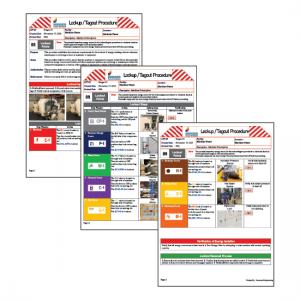Frequently Asked Questions
What is Lockout Tagout (LOTO)?
Lockout Tagout (LOTO) refers to the procedures established for Control of Hazardous Energy, as described by the Occupational Safety and Health Administration (OSHA) under Federal Registry 29 CFR 1910.147.
Lockout Tagout (LOTO) ensures employee safety during inspection, Maintenance, or service of equipment by controlling all energy flow to and from the equipment. To achieve system Lockout, all energy sources are turned off or disconnected, and Stored Energy is released, restrained, or Dissipated. A lock or Lockout Device applied to each Energy Source prevents accidental startup.
Tagout refers to application of warning tags to energy sources to ensure the equipment is not restarted until service has been completed. Tags may be used with locks for enhanced safety assurance. Where Lockout is not possible, tagout may be an alternative. Tagout alone is not as secure as is lockout.
What is a Lockout Tagout (LOTO) Program?
A Lockout Tagout (LOTO) program must include the following:
- Plant- or company-wide safety policies
- Machine-specific lockout procedures
- Lock, key and tag control
- Program review and certification
- Outside contractor rules and regulations
Training for employees includes classroom and hands-on instruction. Authorized employees must demonstrate their proficiency in startup and shutdown procedures. A copy of OSHA 29 CFR1910.147 should be readily available for reference.
Who must have a Lockout Tagout (LOTO) Program?
All companies whose employees service or maintain equipment with potentially Hazardous Energy sources must have an OSHA-compliant Lockout Tagout (LOTO) program.
When does Lockout Tagout (LOTO) apply?
Lockout Tagout (LOTO) applies whenever the employee performs service or Maintenance on equipment/machinery that requires the employee to remove or bypass a guard or safety device or requires the employee to place any part of his/her body at the point of operation of the equipment/machinery.
What is the LOTO Procedure?
The LOTO procedure is a pretty straight forward safety policy that has saved thousands of lives and prevented many more injuries. The exact steps taken will vary some from company to company, but the basic requirements are as follows:
- Power is disconnected – The first step is to physically remove all power sources from a piece of machinery. This includes the primary pour source and all backup sources as well.
- Lock Out the Power – Next, the person who will be working on the machinery will physically lock the power out. This typically means putting an actual lock around the plug so that it can’t be inserted into the machine. If there is more than one plug, then multiple locks will be needed.
- Filling Out the Tag – The lock will have a tag on it that provides information about who removed the power, and why. This will further help to inform those in the area that they should not attempt to energize the machine at this point.
- Holding the Key – The person who is actually entering the machine or other hazardous area will hold on to the key to the lock. This will ensure that nobody can remove the lock and restore power while the worker is still in a hazardous area.
- Restoring Power – Only after the work has been completed and the worker has existed the area where danger exists can they remove the lock and restore power.
Creating a LOTO Program
Any company that has potentially dangerous machinery will need to have a LOTO program developed. The steps listed above will give general guidance on how the program should be developed. The specifics regarding things like what is written on a tag, what situations the program is used, and other factors can be determined by the safety manage of the facility.
Which employees are at risk of injury?
Employees at risk of injury from equipment and machines varies depending on what they are doing. There are two categories of employee:
- Authorized Employees or Persons – A qualified person who locks out or tags out specific machines or equipment in order to perform cleaning, repairing, servicing, setting up, and adjusting operations on that machine or equipment. An Affected Employee becomes an Authorized Employee when that employee’s duties include performing cleaning, repairing, servicing, setting up, and adjusting operations covered under this section.
- Affected Employees – An employee whose job requires them to operate or use a machine or equipment on which cleaning, repairing, servicing, setting up or adjusting operations are being performed under lockout or tagout, or whose job requires the employee to work in an area in which such activities are being performed under lockout or tagout.
Who benefits from LOTO?
The Lockout Tagout (LOTO) program is designed to help improve safety in a facility. When implemented correctly, it can help to dramatically reduce the risk that someone or something will be in danger when working in or around machinery. This can include protections from being crushed, hit by moving parts, electrocuted, cut, or experience other types of injuries. Many people benefit from the LOTO program, which is one of the major reasons why it has become such a vital part of many facility safety systems.
Employees Working in & Around Machinery
The most direct benefit from LOTO is going to be for the employees who work in and around heavy machinery. Prior to the widespread implementation of this program hundreds of people would be killed each year, and thousands more injured, because of accidents related to unintended energization of machinery while it was being worked on.
Company Owners
The LOTO program is a requirement by OSHA in many situations. This means that all facilities need to follow it if their situation falls under the scenarios listed by the governmental agency. Any violations of these requirements will result in fines and penalties, so following the LOTO processes is going to have significant benefits.
In addition, the company will benefit from the improved safety that comes with this process. Increasing safety helps to benefit the company as a whole because it reduces down time, costs associated with fixing a machine, and much more.
Customers
Even customers will benefit from the LOTO program, though not as directly. When a facility has a serious accident or other similar event it can cause serious delays in production. In addition, this type of thing can cause damage to machinery, which will end up causing problems for the product being produced. Taking the right steps to prevent accidents will help to ensure customers are able to get what they need, and with the highest quality possible.
Which energy sources require Lockout?
Any energy source that presents a potential hazard must be locked out.
- Electrical
- Pneumatic
- Hydraulic
- Compressed Gas
- Water
- Chemical
- Gravity
- Motion
- Rotation
- Thermal
What are normal production Operations?
Normal production Operations can be described as using machines or equipment to perform their intended production functions.
Is Lockout Tagout (LOTO) training necessary?
Yes. Employees must attend courses presented by qualified instructors.
- Employees who maintain or service equipment must be fully trained in Lockout Tagout (LOTO) procedures. They are “authorized” to conduct Lockout Tagout (LOTO) .
- Operators who do not service or maintain the equipment they use are trained as “affected” employees.
- Employees who have little contact with the equipment receive “other” employee training so as to recognize but not actually perform the
- Lockout Tagout (LOTO) procedures.
- All employees must be trained before working with or on the equipment. Employees receive retraining whenever they are assigned to new equipment.
Is PPE required for Lockout Tagout (LOTO) ?
Workplace safety is an important responsibility of every employer. When there are serious hazards that can cause permanent injuries or even death, it is especially critical to take it seriously. In many cases there are multiple different steps that can be taken to reduce the hazards of a given environment. For example, using a Lockout Tagout (LOTO) strategy can help to eliminate the risk of a machine energizing while someone is working on it. Personal protection equipment can further help by offering protection to the person who is working in the area. Many people wonder if it is necessary to use both of these safety practices in all instances.
Extra Layers of Protection
When done properly, the Lockout Tagout (LOTO) program will virtually eliminate the risk of a machine becoming active unexpectedly while someone is in a hazardous area. This may lead some people to think that wearing personal protection equipment is therefore unnecessary. This is actually not the case. PPE can still help to provide additional protections that would not otherwise be possible. In many machines, for example, there are dangerous cutting arms that could cause serious injury if engaged. While Lockout Tagout (LOTO) may prevent the arms from moving unexpectedly, they won’t protect an employee who accidentally bumps into them. PPE, however, will provide protection from this risk.
In this way Lockout Tagout (LOTO) and PPE are very complimentary and help to turn a potentially very dangerous action into one that is quite safe. For this reason, it is almost always a good idea to use PPE in conjunction with the Lockout Tagout (LOTO) program to ensure maximum safety.
Considering the Costs
Putting on personal protection equipment does have some downsides, however, which should always be considered. For example, wearing a thick suit that is meant to protect someone from electrical shock can reduce visibility and mobility. While this would be worth it if the electrical systems were still on in a machine, it is likely not necessary when the electrical sources are locked out and tagged out.
Employers and employees need to look at each situation and determine what the best way to keep everyone safe will be. In some instances, the ‘costs’ of adding PPE requirements will be greater than the benefits if Lockout Tagout (LOTO) is also being used. Each situation is unique and must be evaluated separately.
What is Lockout Tagout (LOTO) tags?
In the Lockout Tagout (LOTO) procedure, the person who is working in a potentially dangerous area will need to attach a tag to the lock that they are putting on the power cord or other power supply. This tag is where the procedure gets the second half (tag out) of its name. Understanding what a LOTO tag is, and what purpose it serves, is important for successfully implementing this type of safety program in your facility.
Physical Description of a Tag
A Lockout Tagout (LOTO) tag can come in a variety of different designs. Choosing the one that works best for your facility will help ensure they are easily recognizable. While you can pick any design you would like, it is best to stick with only one design at all times so that it does not cause confusion.
In general, these tags will be rectangular with a hole at the top used to fasten it to the lock. The tag itself will be white with red and/or black print. The print should tell those in the area that there is danger present, and that the tag should not be removed or the machine operated. Most tags will also have empty lines where operators can fill out additional information about why the Lockout Tagout (LOTO) procedure is being implemented.
Where Tags are Used
These tags are attached to the lock when removing a power source from a machine. In general, one tag should be applied to each lock. If there are multiple people working on a machine, they should each be adding their own lock with their own tag separately so that there is no risk that one person could re-engage the power while someone else is still working in a hazardous area.
Information On a LOTO Tag
In addition to the generic information letting people know that they should not remove the tag or restore the power to a machine, a LOTO tag should have information about why it is being used. This will typically include the name of the person attaching the tag, the date on which it was attached, and in many cases, details about the work that is being done.
What is Lockout Tagout (LOTO) devices?
When using the Lockout Tagout (LOTO) procedure it is necessary to place a physical device on either the electrical supply cord, or the place where the machinery in question is plugged in. These are the items that will stop other people from inadvertently energize a machine, putting the person in or around it in danger. There are quite a few different types of LOTO devices that a company can use. Knowing about these devices, and the ways they work, can help ensure you pick the right one for your facility.
Padlock Devices
Padlock style LOTO devices are placed on the plug or other part of the electrical system to ensure that it physically can’t be used. There are a number of different sizes and types of padlock that can be used, so make sure to choose one that will be able to be secured to the area where it will be used in your facility. This, and all lockout devices, should say “LOCKED OUT” and “DANGER” right on them so people know why they are there.
Clamp-On Breaker Devices
A clamp-on breaker style LOTO device will open up and then clamp down onto the electrical points to ensure power can’t be restored while in place. This option often fits a wider range of different electrical system, which is why it is quite popular in many facilities. This kind of device is usually red in color so it will easily stand out.
Lockout Box Device
A LOTO box style device simply fits around the electrical plug and closes around the cord. The box is then locked so that it can’t be opened. Unlike many other styles, this one doesn’t fit snugly on the actual prongs of the power cord, but rather isolates it in a large box or tube structure that can’t be opened without the key.
Other Styles of LOTO Device
There are a variety of other types and styles of Lockout Tagout (LOTO) devices that are available too. Some companies even have custom devices built so they fit the exact situation where they will be used. No matter what type of device you are using, you’ll want to make sure that it is able to physically prevent a power cord or other power source from being plugged in. When these devices are used properly, they can help to keep everyone in the facility safer.
How does Lockout Tagout (LOTO) improve safety?
The Lockout Tagout (LOTO) program is one of the most important safety improvement strategies used in workplaces today. It is a relatively simple system that has helped to save many people’s lives, and prevent even more injuries, over the years. Understanding how Lockout Tagout (LOTO) improves safety will show why it is so important to implement in the workplace.
Cutting the Risk of Electrocution
The Lockout Tagout (LOTO) program works by physically removing power sources from machinery. This is typically done when a machine needs to have work done on it for a repair, retooling, or any number of other things. When this is being done, it is possible that a wire will be cut or other electrical work is performed. With the Lockout Tagout (LOTO) program in place, the maintenance professionals can work confidently that they won’t experience an electrocution because the machine was inadvertently plugged back in.
Reducing Arc Flash Hazards
Lockout Tagout (LOTO) programs can greatly reduce the risk of an arc flash explosion. An arc flash is a powerful burst of energy that can cause severe burns, fires, powerful explosions, and more. This could be triggered by someone working on a machine when it is still connected to the power source. The more voltage in the machine, the more dangerous the arc flash could be. This is why Lockout Tagout (LOTO) ensures that the source of the power is removed, and any stored power in the machine is disbursed before work is begun.
Keeping the Machine Disengaged
When someone is working in or around a dangerous machine it is important to ensure the machine remains immobile. Many modern manufacturing machines have many moving arms, welding tools, conveyor belts, and much more. If any of these types of things should be turned on by someone who didn’t realize that work was being performed, the results could be devastating. The Lockout Tagout (LOTO) program prevents this by having the power sources physically locked so they can’t be restored.
While the Lockout Tagout (LOTO) program is quite simple in its setup, it has been proven to be very effective. Any business that takes the safety of its employees and the machines themselves seriously will want to get a Lockout Tagout (LOTO) strategy in place as quickly as possible.
What is the main goal for a Lockout Tagout (LOTO) program?
The main goal for a Lockout Tagout (LOTO) (LOTO) program is to improve the safety of employees who work on potentially dangerous machines. Specifically, it will prevent a machine from being powered up while workers are performing maintenance in a potentially hazardous area. The concepts behind the LOTO program are quite simple, but they have been proven to be extremely effective at minimizing some of the most severe types of workplace accidents and injuries.
Ensure Power is Not Restored
When someone is working in or around heavily machinery that could cause them harm, it is not enough to simply shut it off. A machine that is turned off can easily be turned back on by someone who doesn’t realize that there is someone working on it. In addition, if there is a power surge of some type, it could cause the machine to energize and cause serious danger for the employee.
When the LOTO program is followed, it is physically impossible to restore the power to the machine or to have a surge deliver power to it. This allows the workers to complete the tasks that they are responsible for without having to worry about the risk of a machine turning on while they are there.
Preventing Accidents
Since only the person or people working on or around the machinery will have the ability to remove the lockout device from the power source, there is no way that this can happen unintentionally. This strategy was developed because it provides assurances that the person performing the work physically can’t still be in a hazardous area when they restore the power.
What are typical activities where Lockout Tagout (LOTO) does apply?
Typical activities where Lockout Tagout (LOTO) would apply are cleaning, repairing, Servicing, setting up, adjusting, and unjamming prime movers, machines, and equipment.
What about the safety of outside maintenance and repair contractors?
In addition to ensuring the safety of its own employees, the employer is responsible for the outside Contractor’s on-site personnel. The Lockout Tagout (LOTO) program must include policies, procedures, supervision, and authority for service involving contractors.
What is the difference between an authorized and an affected employee?
An authorized employee is one who performs Lockout Tagout (LOTO) in order to conduct service or Maintenance on equipment and machinery.
An affected employee is one who works in or around the area in which service or Maintenance is being performed. An Affected Employee is not permitted to perform the Lockout Tagout (LOTO) procedure.
Does OSHA endorse or approve a Lockout Tagout (LOTO) service or a product?
OSHA does not endorse or approve any service or product in order to negate conflict of interest. Under OSHA 29 CFR 1910.147 standard, the requirements for Lockout devices are not quantitative, making it difficult to provide the rationale on a decision one way or the other.
How durable are the Deenergize Lockout Tagout (LOTO) procedure placards and tags?
The final Deenergize Lockout Tagout (LOTO) procedures and energy control device identification tags are printed with high-quality, UV-resistant ink on state-of-the-art color printers. The output is then sealed and protected in 20-mil polyester.
All materials used in the manufacture and mounting of our Lockout Tagout (LOTO) procedures and labeling resist damage due to exposure to lubricants, solvents, UV light, temperature extremes and physical abuse.










